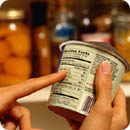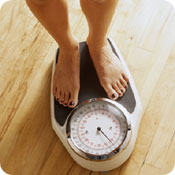 An example of an unhelpful fat-free claim is a carton of 100% orange juice. Here, a fat-free claim isn't helpful labeling, even though it is truthful. Oranges are naturally fat-free, so 100% orange juice always has and always will be fat-free, regardless of whether it is highlighted on the label or not.
An example of an unhelpful fat-free claim is a carton of 100% orange juice. Here, a fat-free claim isn't helpful labeling, even though it is truthful. Oranges are naturally fat-free, so 100% orange juice always has and always will be fat-free, regardless of whether it is highlighted on the label or not. "Zero Trans Fats" Thanks to recent media attention, you probably know that trans fats are bad for your health. Experts recommend that people avoid trans fats, which are created when oils are hydrogenated during food processing. But you can't trust a product's claim of zero trans fats, nor can you trust the nutrition facts label on this one. Always read the ingredients list. If the words "partially hydrogenated" appear in it at all, then the food DOES contain trans fats. But thanks to labeling guidelines, any food that contains 0.5 grams or less of a nutrient can be listed as zero grams on the nutrition facts label. This may seem insignificant, but it does add up. Think about a box of cookies. It says "zero trans fats" on the front of the box and on the nutrition facts label, but it lists "partially hydrogenated oils" in the ingredients list. This food can contain up to 0.5 grams of trans fats per serving, yet the labeling is legit. Over time, when you consume the 6, 10, or 20 servings of cookies in the box, you'll consume 3, 5, or 10 grams of trans fats. Since there is no safe level of trans fat consumption, this food is not good for your health. Making Healthy Choices Most of your food choices should come from whole, unprocessed sources: fresh meat, beans and legumes, real fruits and vegetables, calcium-rich foods like dairy, oats and other whole grains. Remember that you can't make nutritious food selections based solely on the marketing phrases on the front of a package. These buzz words are meant to catch your attention and are put there by marketing gurus so that you'll buy their product. Once you've looked at the package, ask yourself, "Does this food company have my health in mind?" The more processed a food is, the less reliable the claims on its package become. |
The Loopholes of Food Labeling
What Food Manufacturers Don't Want You to Know
‹ Previous Page Page 3 of 3






Member Comments